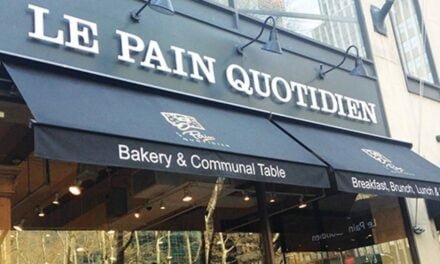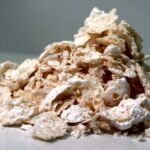In this article, Archana Kushwaha and Dattatreya M. Kadam, briefly discuss the art of baking a good quality bread, ingredients used, the process flow of bread making, quality assurance, and nutrition labeling in bread production in the small-scale bakery industry.
Baking a good quality bread
Bread is one of the oldest foodstuffs. Soon after human beings first learned to plant seeds, bread became the staple food of many cultures worldwide. Since then each culture has developed its own method of making bread using local ingredients and processes. The trend continues today. Quality assurance is however very important for manufacturing good quality bread commercially. This article briefly discusses art of baking a good quality bread, the ingredients used, quality assurance and nutrition labeling in bread production in small-scale bakery industry.
Ingredients for a good quality bread
The most important part of the bread making process is the wise selection of ingredients. The simple rule being applied is: best ingredients ‑ best results, poor ingredients – poor results. For example; if good yeast, good flour and cold water were thrown together and mixed in an old bucket the mixture would still rise! If your loaf does not rise it is due to the ingredients. The information on each major element used in the making of bread which will enable us to obtain perfect results the first time every time is given in the following text.
Flour: Flour contains a protein called gluten, which contributes to the crumb structure and retains carbon dioxide gas produced by the yeast in raised bakery products. Starch in flour forms a paste that is set by heat during baking. Changes to starch contribute to staling of bakery products. Flours can be classified on the basis of their gluten content. They are either ‘strong’ flours with high gluten content (made from ‘hard’ wheat) or ‘weak’ flours with less gluten (made from ‘soft’ wheat). Strong flour is particularly suitable for bread making. Flours having low protein content or bad protein quality are rarely used in bread preparation. For the preparation of bread flour with protein content between 11 and 13% is used.
There are different grades of wheat flour; each described by their ‘extraction rate’ (the amount of starchy material extracted from the grain). Common white flours include ‘straight run’ flour which contains 76-78% of the original wheat and ‘patent’ flour. Straight-run flour is generally used in making bread whereas patent flour is used for making cakes etc. Recently, whole-wheat flours are being used to fortify bread with fibre. Demand for these types of bread is increasing. They have at least 95% extraction and often 100% extraction (i.e. the whole of the grain including bran and germ is ground to flour).
Yeast: Yeast is a microorganism that is grown in yeast factories. Its scientific name is Saccharomyces cerevisiae, which is drived from the Latin word “saccharo”, which means sweet or sugar and the word “myces”, meaning “mould”. Baker’s yeast is a unicellular mould that reproduces through a process, which is known as “budding”.
Bakers use it to make the dough “rise”; without it, our bread would be like flat, hard cakes. In the days when people made their own bread, they would go to a brewer and get a jug of brewer’s yeast. It was fluid and yellow. Nowadays, yeast is made commercially on a large scale. Bakers use either compressed fresh yeast or dried yeast. Compressed yeast, the yellow lumps done up in paper, should be stored in a refrigerator and is active for a few weeks, whereas dried yeast can be stored for years, losing 2-3% of its activity per year under proper storage conditions.
The amount of yeast in dough is normally 0.3-1.0% of the weight of flour. Pressed yeast is mixed with water and added directly into the dough. Dried yeast is activated by mixing it with five times its weight of warm water, a little sugar and leaving it stand until it becomes cloudy with visible gas bubbles. The amount of yeast depends on the temperature and/or the time of fermentation. A change in fermentation temperature of 1.1°C requires a change in the amount of yeast of 20% (e.g. an increase in temperature from 25°C to just over 26°C reduces the amount of yeast by 20%).
The primary function of yeast is to supply carbon dioxide gas, which inflates the dough during proof and the early stages of baking (oven spring). Carbon dioxide cannot form a gas bubble on its own it requires a “nucleating site” (i.e. somewhere it can gather to form a bubble). In bread dough, the nucleating sites are provided by the nitrogen gas bubbles, trapped in the dough during mixing.
The yeast has used up the oxygen from the air. During proof stages the carbon dioxide goes into solution until the solution is saturated and then any more, which is generated, makes its way into the nitrogen gas bubbles, which grow in size, and the dough expands. The more yeast and the warmer the temperature the faster the expansion – we get oven spring because the maximum gassing rate occurs at 40-45°C. In bulk fermentation stages we also get dough expansion from carbon dioxide generation but most of that is lost when the dough is knocked back and divided, so the yeast has to start over again.
Yeast also contributes to dough maturity/development. Though its role is minor compared to improvers in no-time dough, it is more significant in bulk fermentation where the enzymes, especially the proteolytic ones (they modify the gluten proteins), play a significant role.
To sum up, the dough is aerated by the action of the yeast. Yeast ferments the dough, and produce tiny bubbles of gas inside it. As a result, the dough gets fatter and bigger, and rises, of course. Thus when the dough is baked, you have a ‘bold’ loaf, light and airy; when you cut it you can see all the tiny holes formed by the gas, so that it looks like a sponge.
Water: An essential element of any recipe is water, the importance of which is very often overlooked. Bread dough is roughly 40 % water. In making dough, the consistency depends clearly on the amount of water used in making it. The amount of water needed depends on the water-absorbing capacity of the flour and the kind of bread we want to make. The amount of added water depends on the water-absorbing capacity of the flour.
During dough preparation, wheat proteins absorb water and form gluten and give the dough consistency. It is also the solvent or medium for substances like sugar and enzymes that are indispensable for the fermentation. The next essential role is its function in homogenizing all these substances throughout the dough during kneading. The water is also needed for swelling and gelatenisation of the starch. This in its turn improves the easy digestion of the bread. The distribution of the heat through the bread during baking is done by water in the dough. And finally, water influences the organoleptic properties of the of a good quality bread.
Besides the amount of water we are using, its quality also plays an important role. The most important criteria for water is its hardness, which is a measure for the content of calcium and magnesium salts dissolved in the water. Water with a mild hardness is the most useful because the mineral salts reinforce the gluten network. If the hardness is too high (more than 180 parts ppm), the fermentation slows down because of the too rigid gluten structure. Using more yeast or adding malt to the dough is the best way to correct this condition.
In the opposite case, where water hardness is less than 120 ppm, the dough gets sticky. In this case one has to use less water and although the consistency of the dough looks normal, one shouldn’t forget that such dough retains less carbon dioxide during the rise. Bread gets the right volume, but the crumb structure will be shabby when one uses too soft (with low hardness) water. The softness and the keeping qualities are negatively influenced.
Another important factor is the pH of the water used. Acids are responsible for the flavour and the taste of the bread. The acids, necessary for a good organoleptic experience will be neutralized if the alkalinity becomes larger than a pH of 8. The activity of the yeast and lactic acid bacteria drops if their environment becomes alkaline. The enzymatic activity also suffers from a too high pH. Their optimal pH must be in the range of 4.0 to 5.5, which is also excellent for the yeast and the lactic acid bacteria.
The use of too much water is not a suitable practice. The loaf will stay small and flat, the cells of the crumb will be too large, the crust stays pale and the crumb will be wet and not soft. Too little water is also not suitable. The crust will then get tough and the crumb dry.
Salt: Salt gives flavour to bread, strengthens the gluten, and helps retain moisture to reduce staling. Salt’s main function is to bring out the flavour of the baked product. Salt tends to bring out the good flavours and mask the off-flavours. Usage levels are normally between 1.8 % and 2.2 %. Legislation may vary from country to country because the intake of too much salt is considered as a health risk. Bread made with less than 1.6 % salt will taste insipid and bread made with more than 2.2 % will taste too salty.
In addition to impacting flavour, salt also controls the yeast fermentation by inhibiting fermentation due to the osmotic pressure effect. Yeast cells will partially dehydrate due to the osmotic pressure. Salt can be added for instance to sponges to slow down the fermentation rate. Slowing down fermentation rate means that less sugar is metabolised into acids. The result is that the pH of the dough will be higher and the crust colour will be darker. Salt toughens the gluten. Adding salt could actually strengthen weaker flours. Salt lengthens the mixing time so it is common to delay the addition of the salt to the mixer. Faster flour hydration is also seen with delayed salt. The reason why salt toughens the gluten must be sought in the fact that gluten is made of negatively charged proteins. Negatively charged molecules will repel and not attract each other. It is believed that the positive sodium-ions Na+ of the salt play a role in bringing the protein molecules closer to each other.
Lastly, bread with no salt will also have a crust, which is lighter in colour (given the same baking time and oven temperature). This can be explained as follows. Salt will slow down fermentation, so when there is no salt, the yeast activity will increase i.e. the yeast will metabolise more sugar in a given period of time. As a result, there will be less sugars left in the dough and the pH of the dough will be lower (more acids will be formed). Sugars play (together with proteins, moisture and heat) an important role in the Maillard reaction. But the Maillard reaction is also influenced by the pH: a higher pH will speed up the Maillard reaction. So in this case where the pH is lower and where there less sugar is left, the colour of the crust is lighter.
Sugar: Sugar’s main function is to provide food for the yeast. In normal bread production, 3.0 to 3.5 % fermentable solids are required to sustain yeast activity. This food supply can come from added sugar or from the enzymatic conversion of the starch to sugar or from a combination of both. Therefore sugar is not an essential ingredient. Flour contains 2-3% natural sugar and a further 2% sugar is often added to make sweeter bread.
Secondary functions of sugar are related to sugar that is not metabolised by the yeast and which is called residual sugar. As residual sugar levels are higher, crust colour is darker, the taste is sweeter, and moisture retention is improved due to the hygroscopic properties of sugar.
Sugar has the same effect as salt: if too much is used, yeast activity will slow down. This effect can be seen from a 5–6% sugar level. In order to compensate one can add more yeast. The sugar/yeast ratio should be 3/1. If you want to make a product that contains 15% of sugar, the yeast level should be 5% (baker’s percentage).
Fat: Fat is not needed for bread making, but adding 0.5-1% of the weight of flour improves the quality of bread. It gives increased loaf volume, a tenderer and thinner crust, a better crust colour, a softer crumb and an improved flavour. Fat (0.7–1.0%) will suffice to facilitate slicing. The addition of fat helps in the handling of the dough during the make-up process. Besides lubricating the baked crumb, fat also lubricates the dough and this eases dough expansion in the proofer and in the oven. It will also tenderise the crust and improve shelf life by retarding staling.
Milk solids: Milk solids primarily function as nutritional supplements. Milk is high in lysine (an essential amino acid) and calcium and the overall nutritional quality of the milk protein is excellent. Liquid milk may be less user friendly (storage, perishable), however it has the advantage that no dry matter remains in the product. Indeed, milk powder (or rather the denaturated proteins present in the milk powder) will not dissolve completely in the water and remain as dry solids in the crumb. This will give a dryer, less moist crumb. However it should be kept in mind that the milk must have been heat treated because the serum protein in milk has a weakening effect upon the gluten protein in wheat flour.
Bread improvers: Bread improvers or dough conditioners are additives that are used in small quantities in order to improve the quality of bread. Some of them are baking aids i.e. it is not possible to find them back in the final loaf, so they don’t have to be declared. They can be divided into three main categories: enzymes, oxidising agents and reducing agents.
Enzymes: There are 3 main groups of enzymes, which are commonly encountered in baking: amylases, proteases and lipoxygenases.
Amylases are divided into a-amylase and b-amylase. Normally there is enough b-amylase present in the flour but sometimes addition of a-amylase is needed. The a-amylase will cut the starch into smaller units called dextrins and the more a-amylase activity is there, better for the b-amylase because there are more extremities available. So the substrate for the b-amylase is either starch or dextrins and the product is maltose. Flour tends to lack a-amylase and the miller will supplement the flour with a-amylase.
The a-amylase the miller will add can come from three different sources: cereal source (malted barley), fungal source (Aspergillius oryzae) or bacterial source (Bacillus subtilis). The diastatic malt is used to improve dough handling, provides more food for the yeast (as it will contain maltose), flavour, crust and crumb colour and it is a shelf life extender. Fungal amylases work in exactly the same way as bacterial and cereal amylases work. They however are denaturated at lower temperatures. Bacterial amylases do denature at relatively high temperatures and some will remain in the bread after baking.
The enzyme will continue to chop up starch in the baked bread. As starch is one of the main players in the staling mechanism, bacterial enzymes are used as crumb softeners because they will continue to work while the bread sits on the shelf of the supermarket. However there is a danger to it: the bread becomes softer and softer, it also becomes more and more gummy and it is not uncommon that it will flatten collapse while it sits on the shelf in case there is too much bacterial amylase left in the bread.
Protease will react with proteins and weaken them. As a result, mixing time will be reduced; machinability will be improved as well as pan flow (the dough will fill more easily the shape of the pan). These effects are accomplished by breaking the long protein chains, cutting peptide bonds, into smaller units.
Lipoxygenase is also used in the bakery, which is found in soy flour. This enzyme will bleach the flour. Flour contains a yellowish pigment that will be broken down by lipoxygenase. As a result one will obtain a whiter crumb.
Oxidising agents: The baker to improve dough strength uses oxidising agents. Due to the oxidising action, SH-groups in the gluten network will be transformed into –S-S- bonds between the protein chains rendering a stronger gluten network. They will improve dough handling for better machining and contribute to improved gas retention, giving better volume and a more regular grain of the crumb. Some oxidants are fast acting, working in the mixer and early make-up stage.
Calcium peroxide is an oxidant but is used for its dough drying capabilities. It tends to take away the stickiness without stiffening the dough. It reacts immediately on contact with water.
The most widely used oxidising agent is ascorbic acid or vitamin C. It is safe to use. However one needs oxygen to be present because ascorbic acid as such is a reducing agent. In the presence of oxygen however it will become dehydroxy-ascorbic acid and it is actually the dehydroxy-ascorbic acid reacting as an oxidising agent.
Reducing agents: Reducing agents are used to weaken the protein and have the same effect as proteases. The difference being however that the proteases will be destructed by the high temperatures in the oven while reducing agents will remain intact. Reducing agents will reduce mixing time and improve dough machinability i.e. moulding will be facilitated. Reducing agents break bonds between the proteins during mixing. They have the opposite effect of oxidising agents. The most commonly used reducing agent is L-cysteine.
Process of making good quality bread
For consistent production of bread in any bakery industry, ingredients should be accurately weighed in each batch and the same weight of dough or batter should be used for each piece of baked product. Accurate scales should be used and in larger bakeries a dough divider may be needed to handle the larger amounts of dough. Dough loses about 10 – 12.5% of its weight during baking; therefore, a correction factor should be employed in weighing the flour.
Other processing conditions such as fermentation times, mixing times etc. should be accurately controlled and measured with a clock or watch. The temperature of the dough controls the speed of yeast fermentation and so partly determines the amount of product that can be produced per day. It should be between 25-29°C to allow the yeast to work faster. If it is too high (above 49°C) it will kill the yeast and if it is too low the yeast will not ferment the dough quickly enough.
Quality Assurance in bread production
Bread should have a marketable quality and should also be safe for consumers to eat. Simple quality assurance tests are needed to be sure that only the best raw materials and ingredients are used. Even at the smallest scale of production, a quality assurance system can be developed to ensure the quality of bread. A quality assurance system involves the identification of factors (Critical Control Points or CCPs) that could affect either product quality or safety, at every stage of the process, from raw material selection to distribution of products and development of procedures to monitor and control these factors so that they do not cause a problem.
The basis of quality assurance is to prevent problems from arising, rather than trying to cure them afterwards. Factors that should be examined include the ingredients, particularly any spices that might be contaminated with microorganisms and the amounts of any preservatives that are used. Additionally, any sources of contamination from buildings or water supplies should be included. The stages in a process where an error could affect the safety of a product are known, as CCPs .
Quality assurance system in a bakery industry should include the following points:
- Identification of all potential sources of contamination
- Usage of procedures to prevent contamination
- Identification of process control points that can be used to ensure uniform products are routinely produced
- Product weights or package fill-weights should be correct
- Compliance of regulations on product descriptions and/or labeling regulations should be ensured.
Ingredient inspection, process control, training of operators, cleaning and control can check contamination in the bakery industry over packaging and distribution of baked products. Ingredient inspection involves proper storage practices for ingredients, following the rule of ‘First In and First Out’ for their use, keeping a check on pests like mites etc. in storeroom. Before use, flour should be checked to ensure that there is no visible mould growth and that it does not have a mouldy or rancid smell.
Process control involves accurate weighing of ingredients, control over temperatures and times and correct handling procedures. The weighing scales, thermometers and timers that are used for process control should be handled carefully and regularly checked for accuracy.
Cleaning schedules should be preset. Each operator in a bakery industry should know what to clean, how often and to what standard. The manager should produce a list of equipment and the different areas in a bakery industry and indicate how often they should be cleaned and who is responsible. Safe, potable water must always be used to clean equipment. To avoid the risk of residual contamination, the use of detergents and disinfectants should be minimized.
Proper control over the packaging and distribution of bread determines its shelf life. Bread can be wrapped in paper or polythene film. If protection against crushing is important, bread can be packed in cardboard cartons or loaded onto trays for transport. In each case, the only quality assurance procedures are to ensure that the packaging is clean and products are handled carefully.
Quality standards and nutrition labeling of bread
Nutrition labeling and standards for breads in India are governed by the Food Safety and Standards Authority of India (FSSAI), which aims to ensure that consumers have access to accurate nutritional information. The FSSAI has established specific regulations regarding the labeling of various types of bread, which came into effect on May 1, 2023.
The government has made the declaration of the ‘Best Before’ date on label by the manufacturer mandatory with effect from July 1999, according to which all packed food items should necessarily display ‘Best Before’ date. All the manufacturers of bread are advised to put proper labels on the bread along with specified best before date.
There are no legal limits on the amounts of flour, shortening, salt, milk or sugar in bakery products. Standard bread should have a maximum of 38% water, 3% non-wheat flours and 0.25% yeast (each is a % of flour weight). Brown bread should have at least 0.6% fibre. Other specialty breads should have a certain percentage of specified ingredients. For example, enriched bread should have not less than 3% added fat; Milk bread not less than 3.6% added whole milk solids or skimmed milk solids; Wheat germ bread not less than 10% added wheat germ; Gluten bread not less than 16% and not more than 22% protein; High protein bread not less than 22% protein; Fruit bread not less than 6% added fruit; and Malt bread not less than 6% added malt.
It is not necessary to indicate the actual amounts of ingredients used. Water that is used to make biscuit dough does not need to be included as an ingredient as it is less than 5% of the product weight, but should be included in other products if it is above 5%. Likewise, any additive that is used only as a processing aid and has no function in the final product need not be included (e.g. carbon dioxide produced by yeast during bread making). Essences do not need to be individually identified but simply reported on the label as ‘Flavourings’.
Nowadays in order to protect consumer rights, much emphasis is being given to nutrition labeling. Nutrition labeling refers to the standardized presentation of the nutrient content of the food. In India, the idea of bringing out specific laws for nutrition labeling is under active consideration. As of now, it is not mandatory for processed foods in general, except for rules 32A, 37B and 37D of the Prevention of Food Adulteration Act. Rule 32A states that a food claimed to be enriched with nutrients shall give the quantities on the labels. In the case of any food, the nutrition-related claims fall into the following broad categories.
- Nutrition claims: They can be categorized as representations, which state, suggest or imply that a food has particular nutritional properties including energy value, the content of protein, fat, carbohydrates, vitamins and minerals. List of ingredients and mandatory declaration of a certain nutrient cannot be treated as a nutrition claim.
- Nutrient content claims: This is a nutrition claim that describes the level of a nutrient contained in food e.g., low in fat or iron rich.
- Comparative claim: The foods being compared should be of different versions of the same food or similar food. The difference in nutrient content and energy value should be given.
- Nutrient function claim: The physiological role of a nutrient in the growth, development and normal function of the body e.g., contains calcium for stronger teeth could be described.
But if any manufacturer of a good quality bread has any genuine nutrition-related claim for example- fiber-rich bread, iron-fortified bread etc., he or she can earn more money for their value-added bread. The nutrition information on a label may also include a full list of vitamins and minerals, especially the salt content. A label can be used to make claims about the benefits of a specific type of flour, but such claims are illegal if there is a risk that they could give false or misleading information. Claims that are not allowed include those that say a food is wholesome’, ‘healthful or can ‘cure disease’.
In today’s competitive markets, quality assurance and safe bread production have become very important. Any bakery industry with good quality assurance programme can stand the pressures of globalization as well as competitive domestic markets.
‘Processed Food Industry’: The Voice of Food Processing Industry
Processed Food Industry (PFI) is a premier English-language monthly B2B publication (ISSN 09721649) headquartered in New Delhi, catering to the vibrant and ever-evolving food processing industry. While we don’t claim to be the largest or most widely read, our proud legacy of over 27 years—publishing continuously since 1997—has earned us the trust of industry professionals as a reliable source of insights and information.
If your goal is to tap into the booming Indian and South Asian markets to promote your equipment, technology, software, or consumables, PFI is your strategic partner. With our hybrid approach across print, web, and social media, we help you establish strong brand recognition rooted in market relevance. Backed by a team of top-tier technical writers, we’re ready to work closely with you and your customers to craft compelling content that drives results.
India and South Asia’s food industry is expanding rapidly, driven by efficiency and cutting-edge innovations. Don’t miss the opportunity to elevate your brand and engage with this dynamic market. Get our 2025 media kit to fine-tune your marketing strategy, increase your visibility, and convert potential customers into valuable conversations. Additionally, ask for a sample copy of our monthly magazine and experience the quality and relevance we deliver.
Let us help you define your role in the future of the food processing industry.

Have a news or topic to share with industry? Write to us editorial@pfionline.com















